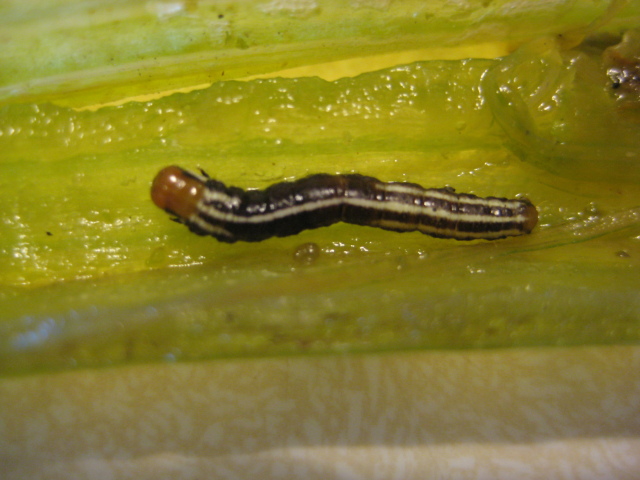Question
 squash pest
squash pest
I am struggling to find the type of culprit that is plaguing my zucchini and yellow strait neck squash. I have done much research on the squash borer - but all information I find states that the caterpillar in the vine is white - I have a caterpillar that is black. Could it just be closer to maturity than not? All other symptoms are the same as the squash borer: wilting stems/leaves, yellow granular frass, etc. The only other different symptom I have that I have not found listed concerning the borer is that some of my produce is rotting on the vine from the blossom end. I suppose this could be a separate problem from the borer.
I garden in Fair Grove, Missouri. This is my first year gardening in raised beds. I have dealt with (and am dealing with) the squash bug, but never the borer before. I will attach an image of the caterpillar I found - any help you can provide would be much appreciated.
Thanks,
Jessica
AnswerJessica, I doubt the caterpillar is your problem. They will leave holes in leaves, but the symptoms you describe definitely suggest the infestation of the squash borer.
Squash borers are very common pests for all members of the squash family. These pests boar into the base of the vine, and eventually spreads a disease that causes the plant to slowly wilt near the base, and eventually die. Depending on how far it has traveled within the stem, it is not always easy to locate them. Unfortunately, once the borer does its damage, there is little chance for the plant to survive. The good news is that the fruit that has already set will continue to ripen and can be harvested.
There are a couple of preventive measures you can take in the future. The first is to cover the plants with reemay while they are just seedlings. Reemay is a lightweight, spun-woven fabric that lets in air, water, and sunshine, but keeps out insects and pests. It is commonly sold at garden centers as floating row covers. Just be sure to remove the covering once the plant begins to flower to enable access by bees for pollination.
The second option is to wrap your stem with aluminum foil. Many gardeners do this routinely with much success. I would personally recommend covering the plants when young, and then wrapping the stem once the plant begins blooming.
Attached is a website that will give you additional information on the squash borer.
http://www.ag.ohio-state.edu/~ohioline/hyg-fact/2000/2153.html
In regard to the rotting on the bottom of the squash, this condition is called blossom-end rot. However, it should not be confused with the same name given to black spots on tomatoes, which is caused by a lack of calcium in the soil. When squash rot and shrivel, it is due to inadequate pollination and/or excess water in the soil.
If you do not have enough bees in the area, you can hand-pollinate the flowers of most vegetables by taking a Q-tip or small paint brush and transferring the pollen from the male flower to the female (the female always has a small fruit on the end). This must be done within one day of the female flower blossoming. However, all you need to do with tomatoes is gently shake the plant every couple of days to improve pollination. To attract more bees, grow sunflowers, marigolds, cosmos, or some other bright annual in the immediate area.
One other possibility is that you are over-fertilizing the plants. Many of today抯 water soluble fertilizers are very high in nitrogen. This results in lush foliage but often at the expense of a smaller harvest. Look for a fertilizer higher in phosphorus and potassium. Many companies now market products formulated especially for tomatoes.
In summary, remember to continue fertilizing with a low nitrogen fertilizer once every other week, and only supplement enough water to ensure a depth of 1.5?per week. Water only once or twice per week but very deeply. Shallow watering always results in poor root development and smaller harvests. Also, be sure to mulch heavily with straw or dried grass clippings around the plants to retain moisture, cool the soil, and to reduce the need for watering.
I hope this information helps. Please write again if I can ever be of assistance.
Regards,
Mike






